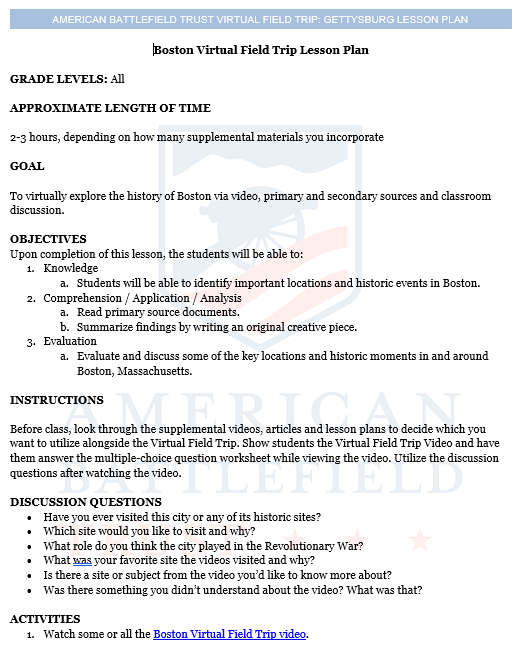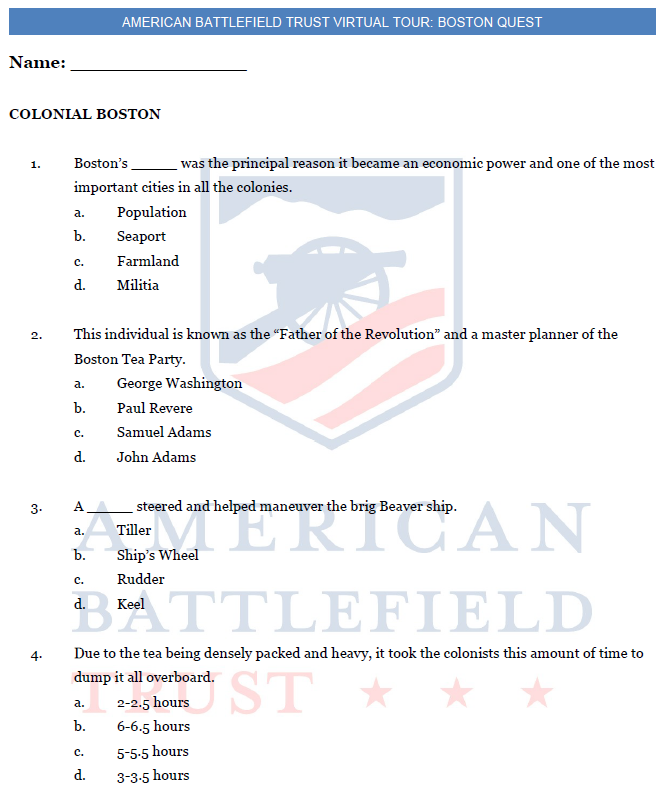
Boston Virtual Field Trip Lesson Plan
A lesson plan for use in middle and high school classrooms.
If you're watching the Boston Virtual Field Trip video with your students, it might be the perfect opportunity to explore even more of Boston's history and culture! This lesson plan includes a range of resources about the start of the Revolutionary War and the civilian experience, the USS Constitution in the War of 1812, and the 54th Massachusetts Infantry Regiment in the Civil War.
This Lesson Plan can be used as a prepared resource by following this curriculum plan which aligns to NCSS and Common Core Standards.
This Lesson Plan's assets can also be used on their own as supplemental resources. The display format is prepared for easy access, exploring, and learning.
To virtually explore the history of Boston via video, primary and secondary sources and classroom discussion.
Upon completion of this lesson, the students will be able to:
1. Knowledge
- Students will be able to identify important locations and historic events in Boston.
2. Comprehension/Application/Analysis
- Read through primary source documents.
- Summarize findings by writing an original creative piece.
3. Evaluation
- Evaluate and discuss some of the key locations and historic moments in and around Boston, Massachusetts.
Check out the Lesson Plan Teaching Guide for more instructions on using the prepared Lesson Plan.
Lesson Plan Primary and Secondary Source Activity:
- Watch some or all the Boston Virtual Field Trip video.
- Conduct a group discussion utilizing the discussion questions:
- Have you ever visited this town or any of its historic sites?
- Which site would you like to visit and why?
- What role do you think the city played in the Revolutionary War?
- What was your favorite site the videos visited and why?
- Is there a site or subject from the video you’d like to know more about?
- Was there something you didn’t understand about the video? What was that?
- Have the students complete the Video Question Quiz Worksheet.
- If the entire Virtual Field Trip video was watched, have the students complete all of it.
- If only some of the Virtual Field Trip video was viewed, have the students complete the relevant sections.
- Have the students complete one of the following exercises utilizing primary and secondary sources to influence a creative piece. In the piece, they should provide an accurate summary of the sources.
Have students read Everyday Life in Boston and read one of these primary sources:
Then, have students write a diary entry or letter about how life in Boston has changed due to the implementation of these acts.
Have students review these Union recruiting posters:
Instruct students to think about what would motivate someone from Boston to enlist in the Union Army during the American Civil War. Have students create their own recruiting poster.
- Complete an optional exercise.
OPTIONAL HOMEWORK/ASSESSMENT/ADDITIONAL ACTIVITIES:
Option 1:
Break students into small groups and assign one or two chapters of the video for each group to watch. Have the groups only watch their assigned sections. After viewing, have the small groups present what they learned to the class.
Option 2:
Have students research one aspect of the video that piqued their interest. They can prepare a 500-word paper or present their findings to the class in the form of an in-person or video presentation.
Option 3:
Have students watch Paul Revere's Ride. Have them consider: how would they get the word out today? Would it be midnight riders like Paul Revere? A text message? An App? A email? Then, have them create a modern-day information relay system, like Paul Revere and his intelligence network. This system could be used to notify others about an upcoming rally, to share information, to coordinate a community effort, etc.
Option 4:
Have students watch USS Constitution and read the biography of USS Constitution Captain Isaac Hull and this primary source. Have students write a plaque commemorating the preservation of the USS Constitution noting its heroic acts and significance to the United States.
Common Core State Standards- ELA & History/Social Studies
Grades 6-8
- Key Ideas and Details:
- CCSS.ELA-LITERACY.RH.6-8.2
- Determine the central ideas or information of a primary or secondary source; provide an accurate summary of the source distinct from prior knowledge or opinions.
- CCSS.ELA-LITERACY.RH.6-8.2
- Craft and Structure:
- CCSS.ELA-LITERACY.RH.6-8.6
- Identify aspects of a text that reveal an author's point of view or purpose (e.g., loaded language, inclusion or avoidance of particular facts).
- CCSS.ELA-LITERACY.RH.6-8.6
- Integration of Knowledge and Ideas:
- CCSS.ELA-LITERACY.RH.6-8.9
- Analyze the relationship between a primary and secondary source on the same topic.
- CCSS.ELA-LITERACY.RH.6-8.9
Grades 9-10
- Key Ideas and Details:
- CCSS.ELA-LITERACY.RH.9-10.2
- Determine the central ideas or information of a primary or secondary source; provide an accurate summary of how key events or ideas develop over the course of the text.
- CCSS.ELA-LITERACY.RH.9-10.2
- Craft and Structure:
- CCSS.ELA-LITERACY.RH.9-10.5
- Analyze how a text uses structure to emphasize key points or advance an explanation or analysis.
- CCSS.ELA-LITERACY.RH.9-10.5
- Integration of Knowledge and Ideas:
- CCSS.ELA-LITERACY.RH.9-10.9
- Compare and contrast treatments of the same topic in several primary and secondary sources.
- CCSS.ELA-LITERACY.RH.9-10.9
Grades 11-12
- Key Ideas and Details:
- CCSS.ELA-LITERACY.RH.11-12.2
- Determine the central ideas or information of a primary or secondary source; provide an accurate summary that makes clear the relationships among the key details and ideas.
- CCSS.ELA-LITERACY.RH.11-12.2
- Craft and Structure:
- CCSS.ELA-LITERACY.RH.11-12.6
- Evaluate the authors' differing points of view on the same historical event or issue by assessing the authors' claims, reasoning, and evidence.
- CCSS.ELA-LITERACY.RH.11-12.6
- Integration of Knowledge and Ideas:
- CCSS.ELA-LITERACY.RH.11-12.9
- Integrate information from diverse sources, both primary and secondary, into a coherent understanding of an idea or event, noting discrepancies among sources.
- CCSS.ELA-LITERACY.RH.11-12.9
Social Studies - National Council for the Social Studies
- Theme 1: Culture
- Theme 2: Time, Continuity, and Change
- Theme 3: People, Places, and Environments
- Theme 6: Power, Authority, And Governance
This Lesson plan
contains the following:
5 Activities | 49 Resources
Audience: Middle school | High school

